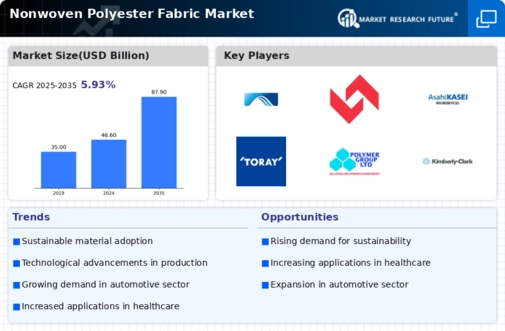Market Growth Projections
The Global Nonwoven Polyester Fabric Market Industry is projected to experience substantial growth over the coming years, with estimates indicating a market value of 46.6 USD Billion in 2024 and a potential increase to 87.9 USD Billion by 2035. This growth trajectory suggests a compound annual growth rate (CAGR) of 5.93% from 2025 to 2035. Such projections highlight the increasing demand for nonwoven polyester fabrics across multiple sectors, driven by factors such as technological advancements, sustainability initiatives, and expanding applications. The market's robust outlook reflects the ongoing evolution and adaptation of nonwoven polyester fabrics to meet contemporary needs.
Growing Demand in Automotive Sector
The Global Nonwoven Polyester Fabric Market Industry experiences a notable surge in demand from the automotive sector, where these fabrics are increasingly utilized for interior applications such as seat covers, headliners, and insulation. This trend is driven by the need for lightweight materials that enhance fuel efficiency and reduce emissions. As automotive manufacturers focus on sustainability, nonwoven polyester fabrics offer a viable solution due to their recyclability and lower environmental impact. The industry's growth is reflected in the projected market value of 46.6 USD Billion in 2024, with expectations to reach 87.9 USD Billion by 2035, indicating a robust expansion trajectory.
Rising Adoption in Healthcare Applications
The Global Nonwoven Polyester Fabric Market Industry is significantly influenced by the healthcare sector, where nonwoven fabrics are extensively used in surgical gowns, masks, and other medical textiles. The inherent properties of polyester, such as durability and resistance to moisture, make it an ideal choice for infection control and hygiene. As healthcare providers increasingly prioritize patient safety and comfort, the demand for high-quality nonwoven polyester fabrics is expected to rise. This trend is likely to contribute to the overall market growth, with a projected CAGR of 5.93% from 2025 to 2035, reflecting the increasing reliance on these materials in medical applications.
Technological Advancements in Manufacturing
Technological advancements in manufacturing processes are reshaping the Global Nonwoven Polyester Fabric Market Industry, enabling the production of high-performance fabrics with enhanced properties. Innovations such as spunbond and meltblown technologies allow for the creation of nonwoven fabrics that are lighter, stronger, and more versatile. These advancements not only improve the quality of the end products but also enhance production efficiency, reducing costs for manufacturers. As a result, the market is poised for growth, with companies investing in state-of-the-art technologies to meet the evolving demands of various industries, including automotive, healthcare, and consumer goods.
Sustainability Initiatives Driving Innovation
Sustainability initiatives are becoming a pivotal driver for the Global Nonwoven Polyester Fabric Market Industry, as manufacturers seek to develop eco-friendly products. The shift towards sustainable practices is prompting the use of recycled polyester in nonwoven fabric production, which not only reduces waste but also conserves resources. This trend aligns with global efforts to minimize environmental impact and promote circular economy principles. As consumers and businesses alike become more environmentally conscious, the demand for sustainable nonwoven polyester fabrics is likely to increase, further propelling market growth and innovation in product development.
Expanding Applications Across Various Industries
The Global Nonwoven Polyester Fabric Market Industry is witnessing an expansion of applications across diverse sectors, including construction, filtration, and consumer goods. Nonwoven polyester fabrics are increasingly utilized in geotextiles, air and water filtration systems, and disposable products. This versatility is driving demand as industries recognize the benefits of nonwoven fabrics, such as lightweight construction, ease of use, and cost-effectiveness. The broadening scope of applications is expected to contribute to the market's growth, as companies explore new opportunities and innovate to meet the specific needs of various sectors.























